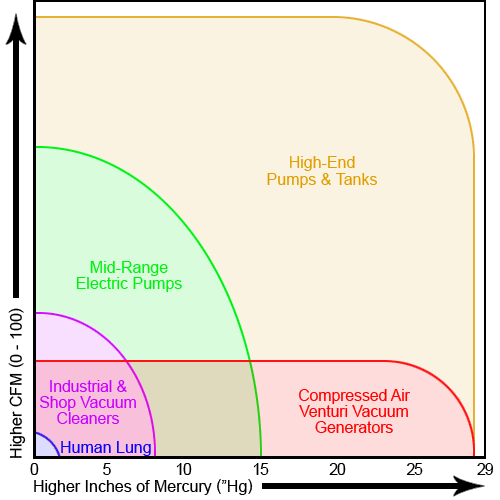Choosing the right vacuum pump for your application is critical. Not all vacuum pumps are created the same, or even use the same terminology for that matter. Let’s dig deeper.
The All Important Terminology
First let’s look at some definitions that you’ll see when comparing pumps. The first is the term CFM which stands for Cubic Feet per Minute. This is a measurement of the speed of the vacuum flow. This can be equated to a car’s top speed. You’ll see this term most often on electric rotary vane pumps or piston pumps (reverse air compressors). Knowing a pump’s CFM is key to knowing how fast you can remove the air from a tank or refrigeration system.
The next key term is Inches of Mercury or abbreviated as “Hg. This is a measurement of the ultimate power of the vacuum. This can be compared to a car’s horsepower. You’ll see this term on high performance vacuum pumps connected to vacuum chucks where holding power is the most important factor regardless of how long it takes to reach the full vacuum level. Knowing a pump’s maximum Inches of Mercury will tell you how secure of a hold you can achieve.
The majority of all mid-range electric style vacuum pumps will list their CFM and omit their max “Hg. This is because they assume the pump is being purchased as a replacement or the user knows that a high vacuum rating is not an issue. Pumps for vacuum chucks that draw a high CFM are often used in the woodworking industry where porous wood and particle board creates a constant leak. High end pumps that are used in machining plastics and metals require higher holding forces. The maximum Inches of Mercury is key to these pumps.
Price vs. Performance
Sure, a high maximum vacuum coupled with high CFM would be great, but expect to pay for it. Here is a basic price range breakdown of the vacuum pumps seen above:
- Human Lung – Cost: Free, Max Vacuum: very low, CFM: very low, Power Use: energy drink
- Shop Vacs – Cost: $20 to $200, Max Vacuum: low, CFM: high, Power Use: low
- Mid Range Electric Pumps – Cost: $200 to $750, Max Vacuum: moderate, CFM: moderate, Power Use: low
- Venturi Generators- Cost: $150 to $600, Max Vacuum: very high, CFM: low, Power Use: requires compressed air
- High End Pumps- Cost: $2000 to $5000, Max Vacuum: very high, CFM: very high, Power Use: very high

